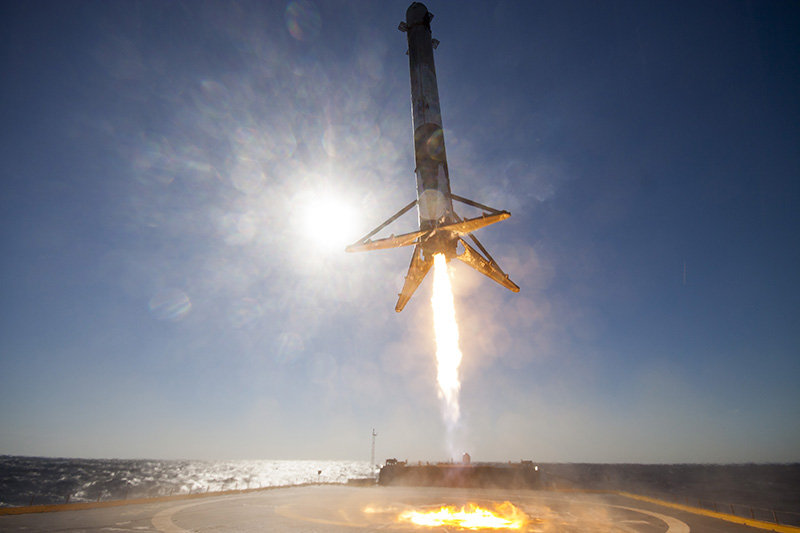The Next Bold Frontier: Space PR
In case you missed it: after four failed attempts, SpaceX, the private aerospace company founded by Elon Musk, managed to land a rocket on a remote-controlled “droneship” floating in the Atlantic Ocean. The stunning ship landing, in fact, followed the more prosaic, but also successful, touch down late last year of a SpaceX rocket into a ground-based landing site at Cape Canaveral, Florida.
Chances are, though, that you didn’t miss it. Not a shining minute.

SpaceX released photographs of their launch directly onto Flikr. (Visual by SpaceX)
Shortly after the landing, the company posted photos and videos to the public photo-sharing service Flickr. Musk, in a classic founder gloat, set a video of the landing to the 2009 Lonely Island party song, “I’m on a boat,” and posted it to Twitter. (Sadly, he’s since deleted the tweet.) The glittering promotion, the solid-gold ‘cool factor’ message, served as a reminder that private space companies are not only taking up the National Aeronautics and Space Administration’s old rocket business, they’re starting to outdo the federal agency at a game in which it had long been regarded as a star: self-promotion.
The corporate space flight business was essentially banned until 2004, when The Commercial Space Launch Amendments Act opened the field to any citizen with enough money who was willing to pay for space flight. Since then, private companies have been hailed as the future of space exploration and have moved aggressively into the research realm.
Just last week, another star-studded space team, made up of Russian tech entrepreneur Yuri Milner, physicist Stephen Hawking, and Facebook founder Mark Zuckerberg, got into the game, with the announcement of their “Starshot” project. The mission reads like a surrealist sci-fi novel: the group plans to send a group of tiny space drones to Alpha Centauri, the star system nearest to our own at 4.37 light years away, allowing them to beam photographs – one assumes dazzling ones at that – via laser back to Earth.
The introduction of private industry into space flight has been credited with generating a new generation of excitement for space exploration. But a lot of these missions are more hype than substance. While the Starshot project has generated a lot of press, it’s also not happening for a while. The project’s team estimates that the mission is at least 44 years out: 20 years of technical prep, another 20 years of travel time, and four years for the photographs to beam their way back. As Dennis Overbye pointed out in The New York Times, the project is “a cosmically big ‘if’ that would occur decades and perhaps $10 billion from now.”
“Much of this plan is probably half a lifetime away,” he continued.
Similarly, the much-hyped “Mars One” mission, which is expected to use SpaceX rockets, has been criticized for lacking the infrastructure of, say, an actual space flight. It’s “essentially a reality TV show that lacks a serious plan, adequate funding, or hardware,” wrote Joel Achenbach in the Washington Post.
That’s not to say there aren’t practical implications of SpaceX’s latest success. Completing a secure landing allows engineers to reuse the equipment after flight—an important accomplishment from a financial and sustainability perspective. And water landings are a key part of that. In fact, SpaceX is partnering with NASA on making sure that the program continues on a solid trajectory. As The Verge recently reported, NASA’s vice president of mission assurance for SpaceX, said at a recent press conference that it’s likely that a majority of rocket landings will take place on floating droneships.
That press conference got more traction than a recent NASA-only project, a part of their new ‘public private’ partnership effort. Specifically, the agency installed an inflatable habitat on the International Space Station, the first human-rated structure of its kind, shipping it using a SpaceX flight. Of course, the publicity for the project wasn’t as streamlined as its private sector peers: The structure has a clunky name, the Bigelow Expandable Activity Module, or BEAM, and rather than posting pictures directly to NASA’s Flickr account, the agency requested that the media watch the launch via NASA TV or by an emailed request for images.
Call that either a missed opportunity or a slightly discouraged press office. Because if you take a look here, the BEAM images are also solid-gold cool.
CORRECTIONS: This post has been updated and edited in numerous places to make clear that Mars One is not a SpaceX project, although the enterprise is negotiating to use SpaceX equipment. It has also been modified to correctly identify the name of the company, which is SpaceX, not Space X.











Comments are automatically closed one year after article publication. Archived comments are below.
Mars One isn’t a Space X mission; it’s led by a private organization in the Netherlands. Mars One has said they want to use Space X rockets, but I don’t think Space X has signed up.